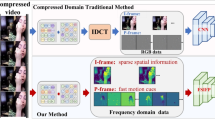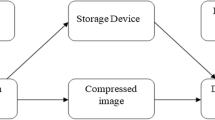Abstract
In this paper, we propose a novel AQ (Adaptive Quantization) algorithm to improve the subjective coding performance. Firstly, the factors affecting a suitable adaptive quantization method are carefully analyzed. Two important conclusions are drawn to guide designing a suitable AQ method. Secondly, based on the drawn analysis, a novel SATD (Sum of the Transformed Difference) based temporal adaptive quantization method is proposed. The proposed method fully considers the temporal characteristics, which can produce more visual-friendly QP (quantization parameter) offset distribution. Experiments are performed on x264 and HM16.0, respectively. With SSIM (Structure Similarity) as the metric, more than 21.07% BD-Rate (Bjontegaard-Delta Rate) saving can be achieved on x264, and on HM16.0, 8.07% and 7.99% BD-Rate savings can be obtained for LDP (Low-Delay-main-P) and LDB (Low-Delay-main-B) configurations, respectively, which is better than the state-of-the-art methods.








Similar content being viewed by others
References
Beermann M, Wien M, Ohm JR (2002) Look-ahead coding considering rate distortion optimization. Image Processing. Proceedings. 2002 International Conference on. IEEE, pp 93–96
Bossen F (2013) Common test conditions and software reference configurations. JCTVC-L1100, Geneva
Brooks AC, Zhao X, Pappas TN (2008) Structural similarity quality metrics in a coding context: exploring the space of realistic distortions. IEEE Trans Image Process 17(8):1261–1273
Dai Y, Liu D, Wu F (2017) A convolutional neural network approach for post-processing in HEVC intra coding. International conference on multimedia methoding. Springer, Cham, pp 28–39
Draft I. recommendation and final draft international standard of joint video specification (ITU-T Rec. H. 264| ISO/IEC 14496-10 AVC) (2003) Joint Video Team (JVT) of ISO/IEC MPEG and ITU-T VCEG, JVTG050, 33
Everett H III (1963) Generalized Lagrange multiplier method for solving problems of optimum allocation of resources. Oper Res 11(3):399–417
Garrett-Glaser J (2009) A novel macroblock-tree algorithm for high-performance optimization of dependent video coding in H. 264/AVC. Tech. Rep
Grassi G, Grieco LA (2005) CNN-based architecture for real-time object-oriented video coding applications. Int J Circuit Theory Appl 33(1):53–64
ISO/IEC/JTC1/SC29/WG11 (1993) MPEG-2 Test Method 5, chapter 10. Rate control and quantization control
Kokkonis G, Psannis KE, Roumeliotis M, Schonfeld D (2016) Realtime wireless multisensory smart surveillance with 3dhevc streams for internetofthings (iot). J Supercomput:1–19
Li B, Xu J, Zhang D, Li H (2013) QP refinement according to lagrange multiplier for high efficiency video coding. IEEE International Symposium on Circuits and Systems (ISCAS), pp 447–480
Li S, Zhu C, Gao Y et al (2016) Lagrangian multiplier adaptation for rate-distortion optimization with inter-frame dependency. IEEE Trans Circuits Syst Video Technol:117–129
Lin R, Zhang Y, Wang H et al (2016) Deep convolutional neural network for decompressed video enhancement. Data Compression Conference (DCC), IEEE, pp 617
Memos VA, Psannis KE (2016) Encryption algorithm for efficient transmission of hevc media. J Real-Time Image Proc 12(2):473–482
Psannis K, Ishibashi Y (2006) Impact of video coding on delay and jitter in 3G wireless video multicast services. EURASIP J Wirel Commun Netw 2006, Article ID 24616:1–7
Psannis K, Ishibashi Y (2008) Enhanced H.264/AVC stream switching over varying bandwidth networks. IEICE ELEX J 5(19):827–832
Psannis K, Ishibashi Y (2008) Efficient flexible macroblock ordering technique. IEICE Trans Commun E91B(08):2692–2701
Psannis KE, Hadjinicolaou M, Krikelis A (2006) MPEG2 streaming of full interactive content. IEEE Trans Circuits Syst Video Technol 16(2):280–285
Recommendation I. 500-11 (2002) Methodology for the subjective assessment of the quality of television pictures. International Telecommunication Union, Geneva
Rohaly AM, Libert J, Corriveau P et al (2000) Final report from the video quality experts group on the validation of objective methods of video quality assessment[J]. ITU-T Standards Contribution COM 1:9–80
Sheikh HR, Bovik AC (2006) Image information and visual quality. IEEE Trans Image Process 15(2):430–444
Sullivan GJ, Wiegand T (1998) Rate-distortion optimization for video compression. IEEE Signal Process Mag 15(6):74–99
Sullivan GJ, Ohm J, Han WJ et al (2012) Overview of the high efficiency video coding (HEVC) standard. IEEE Trans Circuits Syst Video Technol 22(12):1649–1668
Tourapis AM, Au OCL, Liou ML (2001) Predictive motion vector field adaptive search technique (PMVFAST): enhancing block-based motion estimation. Photonics West 2001-Electronic Imaging. International Society for Optics and Photonics, pp 883–892
Wang Y (2006) Survey of objective video quality measurements. Retrieved fromhttp://digitalcommons.wpi.edu/computerscience-pubs/42
Wang Z, Simoncelli EP, Bovik AC (2003) Multi-scale structural similarity for image quality assessment. In: Proc. IEEE Asilomar Conf. Signals Syst. Comput., pp 1398–1402
Wang M, Ngan KN, Li H et al (2015) Improved block level adaptive quantization for high efficiency video coding. Circuits and Systems (ISCAS), 2015 I.E. International Symposium on. IEEE, pp 509–512
Xiang G, Jia H, Yang M et al (2017) An improved adaptive quantization method based on perceptual CU early splitting for HEVC. Consumer Electronics (ICCE), IEEE International Conference on. IEEE, pp 362–365
Yan C, Zhang Y, Xu J et al (2014) A highly parallel framework for HEVC coding unit partitioning tree decision on many-core processors. IEEE Signal Process Lett 21(5):573–576
Yan C, Zhang Y, Xu J et al (2014) Efficient parallel framework for HEVC motion estimation on many-core processors. IEEE Trans Circuits Syst Video Technol 24(12):2077–2089
Yan C, Zhang Y, Dai F et al (2014) Parallel deblocking filter for HEVC on many-core processor. Electron Lett 50(5):367–368
Yan C, Zhang Y, Dai F et al (2014) Efficient parallel HEVC intra-prediction on many-core processor. Electron Lett 50(11):805–806
Yang T, Zhu C, Fan X et al (2012) Source distortion temporal propagation method for motion compensated video coding optimization. Multimedia and Expo (ICME), IEEE International Conference on. IEEE, pp 85–90
Yeo C, Tan HL, Tan YH (2013) SSIM-based adaptive quantization in HEVC. Acoustics, Speech and Signal Processing (ICASSP). IEEE International Conference on. IEEE, pp 1690–1694
Yeo C, Tan HL, Tan YH (2013) On rate distortion optimization using SSIM. IEEE Trans Circuits Syst Video Technol 23(7):1170–1181
Zhu Y, Lucey S (2015) Convolutional sparse coding for trajectory reconstruction. IEEE Trans Pattern Anal Mach Intell 37(3):529–540
Zhu C, Jia H, Liu J, Ji X, Lv H, Xie X, Gao W (2014) Multi-level low-complexity coefficient discarding scheme for video encoder. In: Circuits and Systems (ISCAS), 2014 I.E. International Symposium on IEEE, pp 5–8
Acknowledgments
This work is partially supported by the National High Technology Research and Development Program of China (863 Program) under contract No.2015AA015903, the National Science Foundation of China (61421062, 61502013), the Major National Scientific Instrument and Equipment Development Project of China under contract No. 2013YQ030967.
Author information
Authors and Affiliations
Corresponding author
Rights and permissions
About this article
Cite this article
Xiang, G., Jia, H., Yang, M. et al. A novel adaptive quantization method for video coding. Multimed Tools Appl 77, 14817–14840 (2018). https://doi.org/10.1007/s11042-017-5064-4
Received:
Revised:
Accepted:
Published:
Issue Date:
DOI: https://doi.org/10.1007/s11042-017-5064-4




